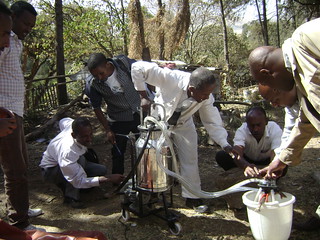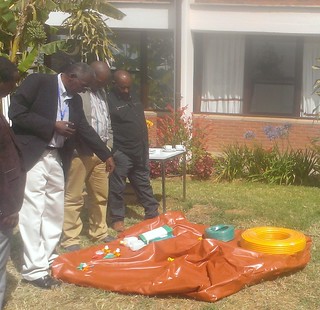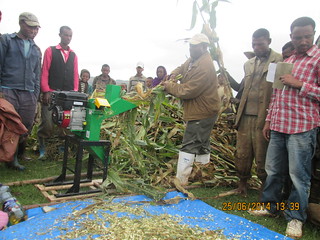Mechanization of livestock production is not given sufficient attention in Ethiopia’s livestock development programs. Most of the country’s livestock production is dependent on manual work, both in rural smallholder and peri-urban/urban medium-scale systems. However, in order to move the smallholder livestock value chain forward, introduction of modern livestock technologies and appropriate mechanization is essential.
Mechanization of the livestock sector would include optimizing productivity (for example, ensuring that cows are milked quickly and completely to remove all the milk in the udder, improving labour management to reduce cost of production, relieving women and girls in rural Ethiopia from the burden of farm and household activities and using livestock waste to generate bio-gas energy and reduce environmental pollution (particularly in urban dairies). Livestock waste can be used to generate biogas, which if packaged and stored, could be used for other purposes beyond providing cooking and lighting.
In the dairy value chain, manual daily farm operations like milking, barn cleaning and feeding are heavy burdens for rural women and children. This could also lead to unhygienic livestock products such as unhygienic milk from poor milk handling practices.

Portable milking machine introduced by LIVES (Photo credit:ILRI\Solomon Gizaw)
The Livestock and Irrigation Value chain for Ethiopian Smallholders (LIVES) project has introduced a number of dairy technologies, including single and double bucket portable milking machines, biogas packages (including above-ground plastic digester, biogas pump/compressor, biogas storage bag and biogas electric generators) and cow mats. Use of portable milking machines, biogas electric generators and cow mats is entirely new in Ethiopia. LIVES is also introducing technologies, such as Hormostos progesterone kits and heat mount detectors, to improve synchronized artificial insemination (AI) services in Ethiopia.

Improved poultry cage with hygienic and automatic feeding and watering facility introduced by LIVES (Photo credit:ILRI\LIVES)
In addition to these dairy technologies, LIVES is introducing technologies to boost poultry production in Ethiopia including improved chicken feeding, watering and housing as an alternative to the widespread scavenging system of chicken production in the country. The project is also improving the poultry value chain by reducing constraints in delivery of inputs and services. For example, LIVES has introduced technologies such as small scale incubators to improve supply of day-old chicks by small hatcheries, which in the past relied on large-scale commercial hatcheries.
LIVES has also introduced technologies to improve Ethiopia’s small ruminant and honey value chains. To address challenges in sheep and goat breeding, which is largely unplanned in conventional breed development strategies, LIVES has introduced a pregnancy detection device known as Preg-Tone, to facilitate planned and hormone-synchronized sheep and goat breeding and production. In the honey value chain, LIVES has demonstrated a honey quality-testing device known as a ‘refractometer’ to improve the quality of honey supplied to the markets.
Feed is a major cost in livestock production, particularly the need for formulated rations for poultry and dairy production. At the same time, inappropriate conservation and use contributes to fodder wastage. To alleviate these challenges, LIVES has introduced fodder choppers and grain shredders to improve fodder use and conservation as well as livestock feed ration formulation from locally available resources.
The LIVES overall strategy is to identify, procure, demonstrate and introduce appropriate livestock technologies suitable for small and medium-scale production systems in its intervention regions, namely Oromia, Tigray, Amhara and the Southern Nations, Nationalities and People’s (SNNP). The project works with partners nationally across the four intervention regions. Technical staff and LIVES-sponsored MSc students from regional bureaus of agriculture (BoAs) and research institutes (RARIs) have been trained on the installation and operation of the various livestock technologies, some of which have already been tested and demonstrated to producers, businesses as well as BoA and RARI staff.
The goal to mechanize small- and medium-scale systems also involves linking the various technologies being introduced. For instance, the biogas technology is expected to supply electricity for milking machines in areas not connected to the national electric grid. Furthermore, the capital costs of the technologies need to be justified by the amount of future wages that they will save. Thus it is important that the technologies are introduced through organized groups such as dairy cooperatives. But the best strategy of introducing the technologies is encouraging partnerships between private sector and producers to ensure sustainable business models that integrate with government efforts to create more jobs for the youth and women.
See more pictures of the livestock technologies LIVES has introduced
Written by Solomon Gizaw (PhD)


I am a dairy man (commercial but small). There are five of us (about the same size farms) clustered in about 500 meters far from each other. We are around Sululta,19 kilometers from Addis. You have all this technology and we haven’t heard about you? I think we should team up. Please contact me via my mail and I will be your gateway to both the commercial and household farmers. If we could just team up we would have our impact on the sector.
I am a dairy Business Lead Entrpreneure ( small scell ) Really it is good oportunity but inorder to get training and any upadeyes on thechnology it is good so .
Here is my E- maill plaese contact me fm172765@yahoo.com
I am an expert leads organic honey producers (in small scale) how can we get honey quality testing device? here is my e-mail mitikuyohannes92@yahoo.com thanks